Golden rays of the maturing sun play hide and seek in the misty-white canvas of yet another dawn in the Kabini Forests. As they sneak through the dancing branches of the windy morning, the violence of silence is broken by a whisper, “an alarm call.” The intruder into the silence is an experienced professional naturalist of Kabini. He asks the Jeep driver to move forward through the pristine, muddy wild tracks into the usual paths of the indigenous predators. Such attempts are possible ways to catch sight of tigers, leopards, wolves, wild dogs, and panthers before they reach their destinations, which are often ponds, water bodies, or the vicinity of prey.
These alarm calls are “vocal signals” sent by monkeys, squirrels, or various birds living atop the crown layer of the forests upon sighting predators on the ground. Their furious expressions turn into signals for other animals, serving as a blessing in disguise. However, these sounds are not yet scientifically proven as deliberate signals but are popularly dubbed “alarm calls,” intended to alert ground-dwelling animals of the presence of predators. In other words, various types of deer, antelopes, wild boars, Indian gaurs, and other animals who have the privilege of a “high-life” are giving clear-cut cautions to ground-level animals to find a safe distance or a defensive hide to save their lives. The communication is passed from the top to the predators.
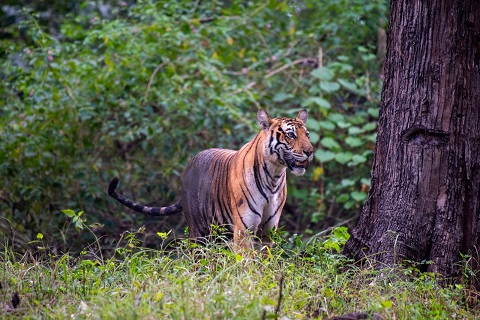

“They are the ‘nature’s CCTV’ that convert visuals into audio signals,” says K. Dinesh Kumar humorously to his French tourists, who is a French-speaking Professional Tour Guide from India Tourism who later translates his words to others, making them break into laughter in the Jeep. A Mysore native, Dinesh is a keen nature enthusiast and a PAN Indian Tour Guide by profession. Then he adds in a philosophical tone “It is Mother Nature’s wonderful principle of sustainable co-existence. Nature is a unique textbook from which the ‘civilized monkeys’ are yet to learn how to live and let live”. Dinesh was assisting a French Media group all over South India and is also well-versed in the Italian language.
These unusual noises as signals are not only understood by the fauna of the forest but also by those who live in tune with Mother Nature, like tribals, forest officials, and naturalists. It is well understood from the change of behaviour among the animals, such as precautions taken by them from possible dangers with a typical movement of their head, high concentration, eerie silence, or other special communicative notions. These are the keynotes for naturalists to find the rarely-spotted big cat family during a wild safari with tourists by Jeep or trekking. The expertise in decoding the language of the wild can be attained only through sheer observation, experience, and patience.
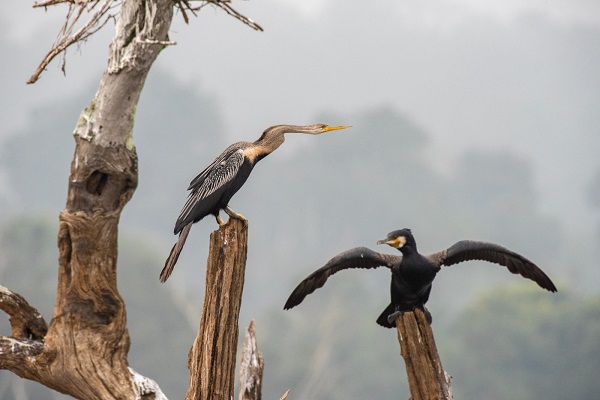

Other than the tourist zones and buffer zones of Kabini Forests, no other wildlife tourist destination in South India offers such incredible probabilities of animal sightings. Once on a jungle Jeep safari, multiple occasions of sighting herds of animals are entirely guaranteed. On the other hand, a rich fauna awaits on the banks of Lake Kabini during jungle boat safaris, with vigilant eyes spotting the “intruders” into their inherited territory.
A usual 2-hour-long Kabini boat safari covers around 27 kilometres. Wherever a visitor looks—left, right, or straight ahead—they are greeted by an abundance of animals, birds, amphibians, and reptiles, all beautifully displayed by nature. “According to the recent tiger estimation, there are 149 tigers. Leopards would be more than 200. We can’t say exactly how many elephants add to the population as elephant counts are not territorial and they keep moving to other nearby forests,” opines Sarath Ramesh, a naturalist who works with Evolve Back Kabini, a resort on the eastern shorelines of Lake Kabini, who possesses a postgraduate degree in environmental science. “As a zoological perception, tigers are territorial and rarely cross their territory as they prefer solitude in nature,” Sarath Ramesh finds. “Even though tigers are solitary in nature, their territories often overlap in Nagarhole National Park too due to the high density of prey in the park.”
Across the entire Nagarhole National Park, there are over 100 tigers, 150 leopards, and 200 wild dogs. These wild cats, as predators, thrive in an exotic environment amidst countless herds of prey, including Indian gaurs, antelopes, deer, monkeys, squirrels, and more.
Kabini Forests rest on the eastern lap of the Western Ghats, belonging to the forest range of Nagarhole National Park on the banks of the River Kabini. The large Lake Kabini, with an area of 24 sq. km, was naturally formed here after the construction of the large Kabini Irrigation Dam. The indigenous biosphere is known as the Nilgiris Biosphere, part of the Western Ghats Mountain Ranges. The Nilgiris Biosphere is enlisted by UNESCO as a World Natural Heritage Site that houses uniquely rich flora and fauna. Hence, one can enjoy exotic boat safaris with cherishing memories, making Kabini a hotspot for “wild travellers.”
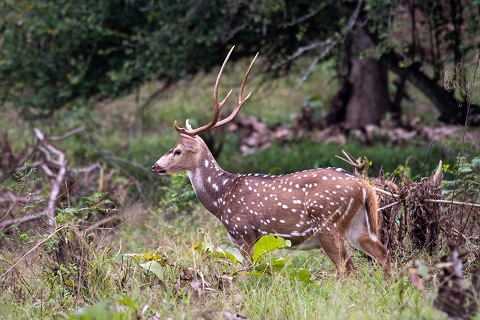

Tour operators are the architects and guardians of Professional Tourism. Without their efforts to explore, discover, and promote unique destinations and experiences, hidden gems like Kabini would remain unknown to global tourists. Hence, they are the masters of the tourism industry. Aneeshmon, the Manager-Tours of Dravidian Trails, a Cochin-based full-fledged inbound tour operator, raises “His Master’s Voice.” “Kabini is the sole wildlife destination where we can assure our discerning tourists a guaranteed wildlife sighting. In most of our Karnataka itineraries, Kabini is a minimum 2-night stay destination with four jungle safaris.” Simultaneously, he airs his concern too. “However, there are concerns like the lack of mid-range accommodation facilities and pre-booking of safaris for people staying at resorts other than government facilities. Though Kabini is an expensive destination it is a worthwhile experience.”
The pre-COVID era witnessed the influx of international tourists into this haven seeking her wilderness, whereas the post-COVID era has seen the flock of domestic and local nature lovers into Kabini. The forests around Kabini Lake alone boast more than 20 tigers, 12 leopards, some herds of elephants, numerous packs of wild dogs, wild cats, herds of Indian gaurs (wild buffalo), and herds of deer of four different species. A rich population of reptiles and amphibians, including crocodiles, live in the region. The 245 species of birds enrich the fauna world of the forests. Indian rollers, bluish-striped birds, are the official birds of Karnataka State and are easily spotted anywhere up above the tree branches or flying around. The usual sightings of other birds here are racket-tailed drongos, hoopoes, scarlet minivets, bulbuls, jacanas, whistling Indian schoolboys, bee-eaters, brown-cheeked fulvetta, owls, and more. Ibis of various kinds, cranes, herons, egrets, robins, grey-winged eagles, and brahminy kites are usual sights near the water bodies during a jungle boat safari.
When Vishnu saw a Green Pigeon dart away, his eyes accidentally fell upon a Tiger cub that was spotted on the shore, nestled in the shadows of the meadows. Vishnu Sadan, an ornithologist and naturalist with Evolve Back Kabini, who escorted a small group of tourists for a boat safari, ecstatically commented in a low voice “It was as if the green pigeon was bringing the tiger cub before my eyes so I could point it out to the fellow travellers on board”.
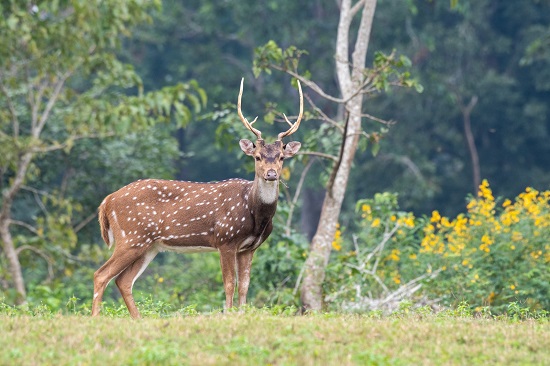

A host of hosts facilitate various modes of overnight staying facilities ranging from luxurious resorts, eco-lodges, and hotels scattered around the lake. The range of forests was once a game sanctuary of the Maharajas of the erstwhile Wodeyar Dynasty of Mysore and the British officials. Their base camp, in a colonial appeal, situated right on the banks of the lake nestled among tall trees and shrubs, is converted into Kabini River Lodge, the first eco-tourism venture by Karnataka Forests and Tourism Departments together. With its 14 large rooms and various cottages, it can lodge 50 visitors to enjoy Kabini Forests and its wildlife activities such as boat safari, coracle rides, and jeep jungle safari.
“In the region, we offer Kabini River Lodge, as our predominant clientele is British, hence the colonial structure nestled among the nature suit to their taste and preferences”, reflects committed professionalism in the words of Vinesh Vidya, the Director-Operations of Global Travel Centre, a Destination Management Company, the headquarters of which is in Essex, UK. Vinesh adds, “We are also focused on minimal effect to the nature, thereby we are strictly following the international eco-tourism principles to avoid Mass tourism trends to a destination like Kabini”.
Evolve Back has evolved into one of the most sought-after resorts in Kabini, thanks to its 37 luxurious rooms designed with a unique tribal concept. “We promote the Kabini Wilderness and offer vehicle safaris and boat safaris as integral parts of every package, ensuring guests experience the wilderness up close. Each excursion is accompanied by an enthusiastic naturalist, making the safaris not only thrilling but also educational,” says Bipin Biddappa, the General Manager of Evolve Back. “Our team of naturalists is well-versed in nature and the environment, allowing us to provide academically insightful safaris, which is the need of the hour,” adds Mr Biddappa.
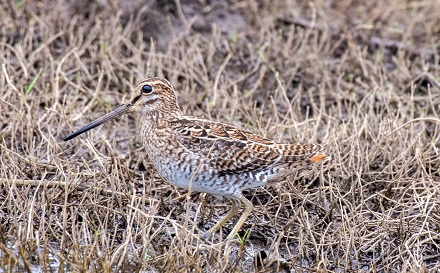

To underline Mr. Biddappa’s views, Albert Antony, a senior PAN India professional tour guide who belongs to India Tourism and hails from Cochin, says, “Mother Nature is primarily a full-fledged university from where any living being learns the basics of life. The knowledge derived from nature ultimately should make a human being love her and, more importantly, preserve her purity for posterity.” He specializes in nature-based itineraries and undoubtedly, one of his favourite destinations is the Kabini range of forests. Albert prefers to identify himself as an Environmental Spiritualist, though an atheist in nature. From his childhood days, his share of thousands of trees to the Planet were planted along the roads for kilometres and around the barren lands in his native city that turned green.
The muse of the wilderness is disguised here as a serpentine seductress. Once you are under the spell of her femininity, you will be trapped in her loop forever. At least once in a lifetime, one has to be submissive to nature here. If so, Kabini makes any visitor a lifetime nature lover with her warmth, aroma and overall charm.
by AJAI KUMAR K S / SRIDEVI NARAYANAN Photography – MANOJ VASUDEVAN
Also Read
Tourism Poised to Smash Records in 2024: WTTC
Watch on Youtube
